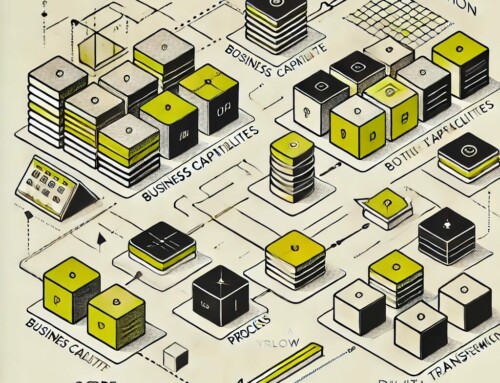
Capability Mapping for Food and Beverage Manufacturer Business Success. Transform your food and beverage enterprise by mapping what matters.
Companies face unprecedented challenges in the highly competitive food and beverage industry – from evolving consumer preferences and complex regulatory requirements to supply chain volatility and sustainability pressures. Responding effectively requires understanding what your organization does today and what it must excel at tomorrow.
A business capability map provides the foundational blueprint that connects strategic vision to operational reality. By systematically documenting and analyzing your organization’s abilities, F&B manufacturers can identify critical gaps, prioritize investments, and align resources to create sustainable competitive advantage. This enterprise navigation tool transforms abstract strategy into actionable transformation roadmaps.
1: Business Capability Maps Explained
A business capability map represents the complete inventory of abilities that enable your F&B company to execute its business model and deliver value to customers. It provides a stable, organization-agnostic view of what your business does.
- Fundamental Building Blocks: Business capabilities define what your organization does (not how or who), representing the core abilities that enable the enterprise to function and compete.
- Organization Neutrality: Unlike process models or org charts that change frequently, capability maps provide a stable reference point independent of how work gets done.
- Hierarchical Structure: Most capability maps use a tiered approach with Level 1 capabilities (major business areas) decomposed into increasingly detailed Level 2-4 capabilities.
- Business-Focused Language: Effective capability maps use terminology that resonates with business leaders, not technical jargon, ensuring broader organizational adoption.
- Strategic Lens: Capabilities provide the crucial link between strategic objectives and tactical implementation, serving as the bridge between vision and execution.
2: The F&B Capability Landscape
Food and beverage manufacturers require a specific set of capabilities that address the unique aspects of the industry, from ingredient management to consumer engagement.
- Industry-Specific Foundation: The F&B capability map must reflect industry-specific requirements around food safety, recipe management, batch production, and regulatory compliance.
- Value Chain Coverage: Comprehensive maps span the entire value chain from agricultural inputs to consumer experience, ensuring no critical capabilities are overlooked.
- Operational Excellence: Production-intensive capabilities require special focus, including manufacturing execution, quality management, and supply chain traceability.
- Innovation Focus: Given the pace of market evolution, product development capabilities deserve particular attention, from concept development to commercialization.
- Digital Dimension: Modern F&B capability maps must incorporate digital capabilities that enable smart manufacturing, consumer engagement, and data-driven decision making.
3: Key Benefits of Capability Mapping for F&B
Capability mapping delivers tangible value to food and beverage manufacturers through improved alignment, prioritization, and decision making.
- Strategic Clarity: Capability maps provide a shared vocabulary and visual representation that helps leadership teams align on what matters most to competitive success.
- Investment Prioritization: By assessing capability performance against strategic importance, organizations can direct resources to the areas with highest business impact.
- Gap Identification: Systematic capability assessment reveals critical gaps and weaknesses that might otherwise remain hidden until they impact business performance.
- Transformation Planning: Capability maps provide the foundation for developing realistic transformation roadmaps that sequence initiatives for maximum effect.
- M&A Support: For acquisition-driven growth strategies, capability mapping accelerates due diligence and integration planning by providing a structured comparison framework.
4: Building Your Capability Map: The Process
Creating an effective capability map requires a structured approach that balances comprehensiveness with usability.
- Preparation Phase: Begin by defining the purpose, scope, and intended applications of your capability map to guide development decisions.
- Discovery Workshops: Conduct facilitated sessions with cross-functional leaders to identify, define, and organize capabilities across the enterprise.
- Hierarchical Development: Start with Level 1 capabilities (major business areas) before progressively decomposing into more detailed Level 2-4 capabilities.
- Validation Process: Test the draft capability map with key stakeholders to ensure completeness, accuracy, and alignment with business language.
- Governance Establishment: Define ongoing ownership and update processes to maintain the capability map as a living asset that evolves with the business.
DID YOU KNOW?
- According to a 2023 food industry survey, companies with mature capability mapping practices are 2.3 times more likely to successfully implement major digital transformation initiatives than those without structured capability models.
5: Core Capability Areas for F&B Manufacturers
While each company’s capability map will reflect its unique business model, most F&B manufacturers share common high-level capability domains.
- Product Management: Capabilities spanning the innovation lifecycle from ideation and formulation to commercialization and product lifecycle management.
- Supply Chain Operations: End-to-end capabilities including sourcing, manufacturing, logistics, distribution, and integrated business planning.
- Quality & Compliance: Capabilities ensuring product safety, regulatory compliance, certifications, and consistent quality standards.
- Customer Management: Capabilities spanning sales, marketing, category management, trade promotion, and consumer engagement.
- Enterprise Support: Foundation capabilities including finance, human resources, legal, facilities, and technology management.
6: Detailed View: Product Management Capabilities
Product management capabilities are critical to innovation and time-to-market in the fast-moving F&B sector.
- Recipe Management: The ability to create, store, revise, and scale formulations while maintaining consistent product attributes across production facilities.
- Product Innovation: Capabilities for identifying market opportunities, developing new concepts, and successfully transitioning from culinary creation to commercial production.
- Packaging Development: The ability to design, specify, and source packaging that preserves product integrity, meets sustainability goals, and enhances brand positioning.
- Product Lifecycle Management: Capabilities for managing the full product journey from introduction through growth, maturity, and eventual retirement or reformulation.
- Nutritional & Regulatory Compliance: The ability to ensure products meet all regulatory requirements in target markets, from ingredient labeling to nutritional claims.
7: Detailed View: Manufacturing Excellence Capabilities
Manufacturing represents a critical competitive battleground for F&B companies, requiring specialized capabilities.
- Production Planning: The ability to schedule production efficiently, balancing demand requirements, inventory targets, and equipment utilization.
- Manufacturing Execution: Capabilities for running efficient production operations, including batch management, line changeovers, and real-time production monitoring.
- Quality Assurance: The ability to maintain consistent product quality through in-process testing, statistical process control, and finished goods verification.
- Maintenance Management: Capabilities for equipment maintenance, calibration, and reliability engineering to minimize downtime and extend asset life.
- Continuous Improvement: The ability to systematically identify and implement operational enhancements through lean techniques, six sigma, and other methodologies.
8: Capability Assessment Methodologies
Once mapped, capabilities must be assessed to identify priorities and guide transformation efforts.
- Maturity Assessment: Evaluate each capability on a defined maturity scale (typically 1-5) to understand current performance against industry benchmarks and requirements.
- Strategic Importance Rating: Assess each capability’s importance to achieving strategic objectives, differentiating between competitive differentiators and table-stakes capabilities.
- Heat Mapping: Visualize the gap between capability maturity and strategic importance to highlight critical areas for investment and improvement.
- Pain Point Analysis: Identify specific operational pain points and associate them with capability gaps to build a business case for improvement initiatives.
- Benchmarking Comparison: Compare capability maturity against industry peers and leaders to identify areas of competitive advantage or disadvantage.
9: Digital Dimension of F&B Capabilities
Digital transformation requires integrating technology considerations into the capability map.
- Technology Enablement: Map the systems, applications, and technologies that currently support each business capability to identify gaps and redundancies.
- Automation Potential: Assess which capabilities could benefit most from increased automation, from robotic process automation to artificial intelligence applications.
- Data Requirements: Define the data needed to effectively execute each capability and identify data quality, accessibility, or integration issues.
- Digital Enhancement: Identify how existing capabilities can be digitally enhanced to improve performance, reduce cost, or create new value propositions.
- Digital-Native Capabilities: Recognize entirely new capabilities made possible by digital technologies, such as direct-to-consumer engagement or predictive maintenance.
10: The Value of Pre-Built Capability Maps
Starting with an industry-specific pre-built capability map accelerates development and improves quality outcomes.
- Time-to-Value Acceleration: Pre-built maps reduce development time from months to weeks, allowing teams to focus on assessment and improvement rather than foundational mapping.
- Industry Best Practices: Quality pre-built maps incorporate industry-specific knowledge and best practices that might be missing from internally developed frameworks.
- Completeness Assurance: Starting with a comprehensive model ensures no critical capabilities are overlooked during the mapping process.
- Common Language: Pre-built maps often include standardized definitions that facilitate benchmarking and external communication.
- Customization Efficiency: Modifying a pre-built map to reflect your organization’s unique needs is far more efficient than starting from scratch.
DID YOU KNOW?
- The average F&B manufacturer has between 80-120 distinct Level 2 business capabilities, yet executive teams typically focus on less than 30% of these when developing strategic plans.
11: Customizing a Pre-Built Capability Map
Adapting a pre-built capability map to your organization’s specific context ensures relevance and adoption.
- Strategic Alignment: Review and adjust the capability definitions to reflect your organization’s strategic priorities and competitive differentiators.
- Organizational Context: Modify capability language to match your company’s terminology while preserving the underlying structural integrity of the framework.
- Granularity Adjustment: Determine the appropriate level of detail for each capability area based on its strategic importance and transformation needs.
- Gap Analysis: Identify capabilities in the pre-built map that may not exist in your organization today but represent potential future requirements.
- Simplification: Remove capabilities that are truly irrelevant to your business model to maintain focus and usability.
12: From Mapping to Transformation
A capability map delivers value when it drives meaningful change and investment decisions.
- Capability-Based Planning: Use the capability assessment to develop an integrated transformation roadmap that sequences initiatives based on strategic impact.
- Investment Alignment: Ensure capital and operational expenditures are directed toward capabilities that create competitive advantage or address critical weaknesses.
- Organizational Design: Align organizational structure, roles, and responsibilities with critical capabilities to ensure proper ownership and accountability.
- Technology Planning: Develop technology roadmaps that directly support capability enhancement priorities rather than implementing technology for its own sake.
- Performance Management: Establish capability-specific key performance indicators that measure progress and outcomes from transformation initiatives.
13: Common Pitfalls and Success Factors
Learn from others’ experience to ensure your capability mapping initiative delivers maximum value.
- Excessive Detail: Avoid creating overly granular capability models that become unwieldy and difficult to maintain; aim for the minimum level of detail needed to drive decisions.
- Technology-Driven Approach: Resist the temptation to organize capabilities around existing systems or technical functions rather than business outcomes.
- Static Thinking: Remember that capability maps are living tools that should evolve as the business and market change, not one-time documentation exercises.
- Limited Engagement: Involve a broad cross-section of the organization in capability definition and assessment to ensure buy-in and accuracy.
- Metrics Disconnection: Ensure capability performance metrics connect directly to business outcomes and financial results to maintain executive support.
14: Case Study: Global Beverage Manufacturer
A leading beverage company used capability mapping to drive a successful digital transformation initiative.
- Capability Baseline: The company began by developing a comprehensive capability map with detailed assessment of current maturity across 120 Level 2 capabilities.
- Digital Prioritization: Through a rigorous assessment process, they identified 15 capabilities with both high strategic importance and significant digital enhancement potential.
- Investment Alignment: The capability assessment resulted in a reallocation of nearly 40% of the technology budget to previously under-resourced high-impact capabilities.
- Organizational Impact: The initiative led to the creation of new roles and teams specifically aligned to critical digital capabilities that lacked clear ownership.
- Measurable Results: Within 18 months, the capability-driven approach delivered a 22% reduction in new product introduction time and 15% improvement in forecast accuracy.
15: Getting Started Today
Begin your capability mapping journey with these practical first steps.
- Executive Sponsorship: Secure support from a senior leader who understands the strategic value of capability mapping and will champion the effort.
- Clear Objectives: Define specific use cases and outcomes for your capability map to ensure it addresses real business needs.
- Quick Start Approach: Consider beginning with a pre-built industry reference model that can be rapidly customized to your organization.
- Focused Scope: Start with a manageable scope, perhaps focusing on one value chain area rather than attempting to map the entire enterprise at once.
- Continuous Value: Plan for quick wins that demonstrate value throughout the process, not just after the complete map is developed.
DID YOU KNOW?
- Organizations that use pre-built industry capability maps report reaching actionable assessment results 60% faster than those that develop maps from scratch, with implementation benefits realized an average of 4.5 months earlier.
Takeaway
Business capability mapping provides food and beverage manufacturers with a powerful tool for connecting strategy to execution. By creating a comprehensive inventory of what your organization does and systematically assessing performance against strategic importance, capability mapping reveals critical gaps and priorities that might otherwise remain hidden. Whether developed internally or adapted from pre-built industry models, a well-crafted capability map becomes the foundation for strategic planning, investment prioritization, and transformation roadmapping. In the rapidly evolving F&B landscape, capability mapping isn’t just a documentation exercise—it’s the essential navigation system for sustainable competitive advantage.
Next Steps
- Evaluate your organization’s current state of capability awareness by conducting a quick assessment of how well your leadership team can articulate and prioritize critical business capabilities.
- Organize a cross-functional workshop to identify your top 10-15 Level 1 capabilities and discuss how they align with strategic priorities.
- Research industry-specific capability reference models that could accelerate your mapping journey.
- Select one strategic initiative currently underway and retroactively map it to the capabilities it will enhance to demonstrate the value of capability-based planning.
- Develop a simple capability maturity assessment for one critical domain (such as product innovation or supply chain) to identify immediate improvement opportunities.
- Create a capability mapping roadmap that outlines how you will progressively develop, assess, and leverage your capability map to drive business value.



